Dolphin/File Management
Template:I18n/Language Navigation Bar
The first section deals with the concepts of different types of bookmarks. The second section takes you on a guided tour of Dolphin.

Bookmarks and Places
In KDE3 you could create bookmarks in Konqueror, but they were not available to any other application. KDE4 opens up a great deal more flexibility - but that inevitably means more complication. In fact KDE4 has three classes of 'Bookmarks', which need to be differentiated. They reside in different files, and have different functions.
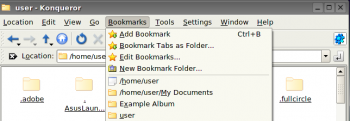
Three kinds of bookmark
First, there is the set of bookmarks available only to Konqueror - web bookmarks. These are stored in ~/.kde/share/apps/konqueror/bookmarks.xml. Then there is a set which Dolphin calls 'Places'. This set is available to all applications as well as the Dolphin file manager. Every time you use File > Open you will see this set. The third set of bookmarks are Application Bookmarks. These share one file, regardless of the application that set them, and are available to all applications, unless you restrain them to a specific application. More of that later.
Enable bookmarks
In most distros Bookmarks are not enabled by default. In order to use bookmarks we first have to enable them. Open a File > Open in most KDE applications and you will see, at the right-hand edge of the icon panel, a spanner or wrench. From the drop-down list, choose 'Show Bookmarks'.
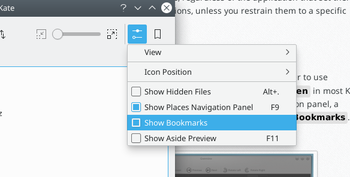
There is a default set of Places -
- Home
- Network
- Root
- Trash
but you can add other places. In Dolphin, right-click on a folder and select "Add to Places".
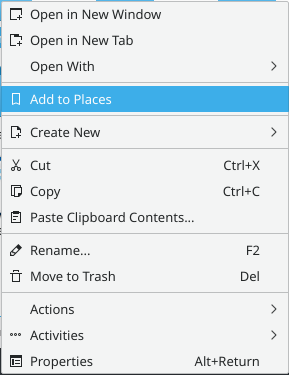
By default this "Place" will be visible in all applications. If you want to keep it constrained to Dolphin, you need to right-click on the new name in the Places list, where you will find the option to Edit it. There is a check-box for "Only show when using this application (Dolphin)".
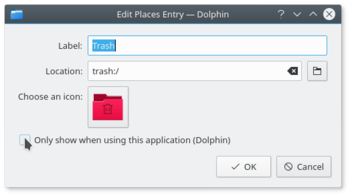
You can see the result of that command if you read ~/.kde4/share/apps/kfileplaces/bookmarks.xml.
In some applications too there is an option in the File menu to add a folder to Places. At this stage, however, applications vary in which features are available. The important thing to remember is that the default is for Places items to be available to all applications in the File > Open dialogue.
Bookmarks in applications
This is the second class of bookmarks. Remember opening File > Open and using the spanner/wrench? Next to it is a yellow star. This is the bookmark management menu.
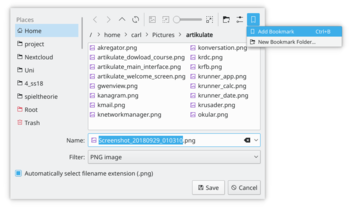
Here you can define bookmarks that will be visible in the same menu on any application. They are stored in one file, ~/.kde4/share/apps/kfile/bookmarks.xml, which is used by all applications having that menu.
Constraining to one application
Some applications allow you to edit items in the Places menu. For instance, if in Gwenview you right click on a folder in Places you can set an option to "Only show when using this application (Gwenview)".
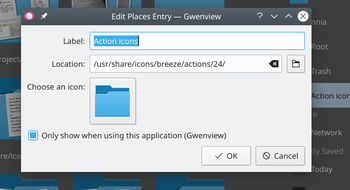
If you need to constrain to an application that does not yet allow you to do that, the only way left is to edit the file ~/.kde/share/apps/kfile/bookmarks.xml. You will need to add the line
<OnlyInApp>appname</OnlyInApp>
immediately before the </metadata> tag.
Discover Dolphin
General information
Dolphin is the file manager of KDE.
I'll show how to use dolphin for common file managing tasks, and how to customize it to your needs.
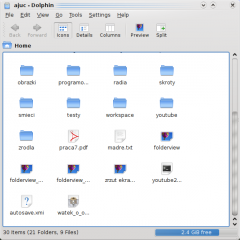
When we open the dolphin from Kickoff menu it shows starting directory - by default it is your Home directory.
To open file, or go to folder just click on it. You don't have to double-click. It's KDE, not windows - you can click only once :).
Selecting files - in KDE, by default when you click once on something, it activates. In Windows you have to double-click for that effect. So, there is problem, what to do in KDE if you don't want to open folder or file, only select it ? Answer is simple - over any icon in dolphin, when you hover your mouse over it, there will be small "+" sign. Like that:
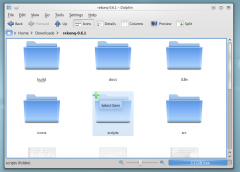
When you click that sign, this file/folder will be added to selection. You can easily select many files in that way (selecting by dragging rectangle also works).
Many selected files looks like this:

We also see here, how we can deselect files - when file is selected, and you place your mouse cursor over it, in place of "+" sign there will be "-". If you click it, the file will be deselected.
Creating a new folder: You can create a new folder in the active directory using the F10 shortcut.
![]() D3lphin is a fork of Dolphin for KDE 3. It lacks some features of Dolphin from KDE 4. It is also less known, because for KDE 3 default file manager was Konqueror. This fork is not supported by KDE and is no longer maintained by its author.
D3lphin is a fork of Dolphin for KDE 3. It lacks some features of Dolphin from KDE 4. It is also less known, because for KDE 3 default file manager was Konqueror. This fork is not supported by KDE and is no longer maintained by its author.
![]() In KDE 4 Dolphin opens by default, when we click on any folder, it can also be started from Kickoff menu.
In KDE 4 Dolphin opens by default, when we click on any folder, it can also be started from Kickoff menu.
Dolphin integrates a new concept to use the navigation bar in a faster and more precise way. Therefore a breadcrumb navigation bar is used. Instead of displaying the complete path only the navigation points starting from one of the places are displayed as buttons. By clicking one of these buttons you navigate directly to this folder. So you can reach a parent folder from a sub folder in a very quick way.
Between the buttons which represent a folder there is a small arrow which is a button as well. By clicking this arrow a list of all sub folders of the folder in front of the arrow is shown. So you can change very fast the selected and displayed sub folder.
There is also a classical navigation bar which displays the complete path. To use this style you can select "View -> Navigation Bar -> Show Full Location" or trigger the keyboard shortcut Ctrl+L. By clicking on the free space next to the last displayed folder in the breadcrumb style you can change to the classical style as well. If the classical style is selected an arrow is displayed at the end of the navigation bar. This arrow is a button which can be used to change back to the breadcrumb style. Of course menu and keyboard shortcut can be used, too.
Split View
Dolphin offers the possibility to split the current folder view so that two folder views are displayed next to each other as known from Midnight Commander. This is a very comfortable view to copy or move files from one folder to another.
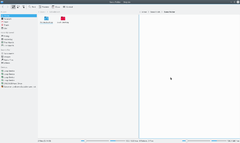
You can split the view with "View -> Split" (keyboard shortcut F3). To change back to only one folder view you can use "View -> Close". The symbol will show you which view will be closed. Depending on the currently active view the minus sign will be shown in the left or right part of the symbol. In general always the inactive view will be closed. This is important to know if you want to use the keyboard shortcut. There is also a button for splitting and closing the view situated in the toolbar. This button displays the minus symbol as well, so it is easy to know which view would be closed.
Of course each view has its own navigation bar and each view can use a different view mode.
View mode
Dolphin supports three different view modes: "Icons", "Details" and "Columns". These can be changed via the menu "View -> View mode" or via the keyboard shortcuts Ctrl+1 (Icons), Ctrl+2 (Details) and Ctrl+3 (Columns). There is also a button for each view mode in the toolbar and the context menu of the folder view offers a submenu "View mode" to change the view mode.
Icons
Each file and each folder is represented by an icon in the view mode "Icons". Instead of displaying an icon a preview of the file can be shown. This behaviour can be turned on/off via the menu "View -> Preview" or via a toolbar button. There exists a size limit for the file previews. This size limitation can be configured via "Settings -> Configure Dolphin -> View Modes -> General" option "File Previews -> Maximum file size". There is also an option to use thumbnails embedded in files.
The files in the currently selected folder are sorted in alphabetical order by default. The way of sorting can be changed via menu "View -> Sort by". The following sort criteria are available:
- Name
- Size
- Date
- Permissions
- Owner
- Group
- Type
Additionally the sorting sequence can be defined by "View -> Sort by -> Descending".
There is the possibility to display additional information below the icons. These can be turned on/off via "View -> Additional Information". In principal the same criteria which are available as search criteria can be selected.
You can group the icons to achieve a better overview. This is turned on via "View -> Show in Groups". Now the icons are grouped and the groups are divided by a horizontal line containing the name of the group as caption. The grouping is related to the selected search criteria.
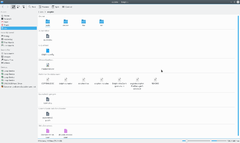
Details
In view mode "Details" additional information are displayed by default in contrast to view mode "Icons". All files are listed in a tabular. The context menu of the table header offers the possibility to add additional columns. The following columns are available:
- Size
- Date
- Permissions
- Owner
- Group
- Type
Column "Name" is always displayed. By clicking on the header of one of the columns the table will be sorted by this column. By clicking on the same column header the sorting sequence is reverted.
Since KDE 4.1 it is possible to display the folders as a tree. In this mode a plus sign is shown next to the folder. By clicking on this sign the folder is expanded and all containing sub folders and files are also shown in the table but they are itenuated. By clicking the sign, which display a minus now, again the expansion is closed again. Of course the tree structure can be used for as many folders as wished. The tree view is disabled by default, but can be activated via "Settings -> Configure Dolphin -> View Modes -> Details" with option "Expandable Folders".
Columns
View mode "Columns" is inspired by the file manager Finder of Mac OS X. Entering a sub folder does not replace the current folder view but the content of the sub folder is listed in an additional column next to the column of the parent folder. This can be used for several hierarchies, so that you can navigate in an easy and fast way in the file system.
Setting defaults for all folders
Under the menu item "View > Adjust View Properties" you can set any of these attributes to be the default for all folder views.
Panels
Dolphin contains several panels, which can be activated via menu "View -> Panels". Each panel can be placed in the left or right docking area. To move a panel you have to click on the header and Drag&Drop the panel. The area where the panel will be placed on mouse released is highlighted. It is possible to stack panels on top of each other. In this case the panels are placed into tabs.
In the header of each panel there are two buttons. The button near to the caption undocks the panel. This makes the panel an independent window which "floats" above Dolphin. The window is still combined with Dolphin and cannot be displayed without Dolphin and cannot for example be minimized like normal windows. By clicking the button again the panel is docked again. The second button will close the panel.
Places
Dolphin contains a kind of bookmarks which are called "Places". These are displayed in a panel which can be activated via "View -> Panels -> Places" (keyboard shortcut F9). The Places are identical to the one shown in the category "System" of the K-Menu Kickoff.
By clicking one of these places it will be opened in the current folder view. The context menu offers the possibility to edit the places or to remove them again. It is also possible to hide entries temporarily.
The context menu of a folder can be used to add this folder an another entry to the Places panel. Therefore there is a menu item "Add to Places". You can also Drag&Drop a folder to the Places panel.
The places panel also contains entries to connected removable devices like USB-keys or CDs. A small plug icon indicates if the device is mounted. The context menu offers the possibility to unmount the device.
The places are used as the basis in the breadcrumb navigation bar. Each address is shown in relation to the nearest parent folder which is one of the places.
Information
The information panel can be activated via "View -> Panels -> Information" (keyboard shortcut F11). This panel displays a preview or an icon of the currently selected file/folder or of the file/folder below the mouse cursor. Some additional information like change date or size to the file/folder are displayed as well.
The information panel offers the possibility to rate files, add a comment or tag a file. This is one of the interfaces to the semantic Desktop Nepomuk which provides the advantages of the semantic web for the desktop. Starting with KDE 4.2 it will be possible to search for the semantic links given by the tags. Currently tagging only offers an outlook to future versions.
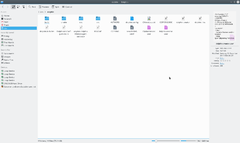
Folders
A panel providing a tree structure for the file system can be displayed via "View -> Panels -> Folders" (keyboard shortcut F7). The tree structure offers the possibility by clicking the + and - signs to expand/collapse sub folders. By clicking on one of the folders the content will be displayed in the current view.
Terminal
The terminal emulator Konsole can be displayed directly in Dolphin via "View -> Panels -> Terminal" (keyboard shortcut F4). So it is possible to use shell commands directly in Dolphin. The terminal is opened in the folder which is displayed in the current view.
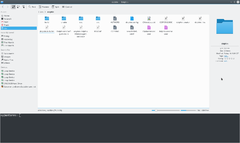
External links
Road to KDE 4: Dolphin and Konqueror
Ars Technica: A First Look at Dolphin
